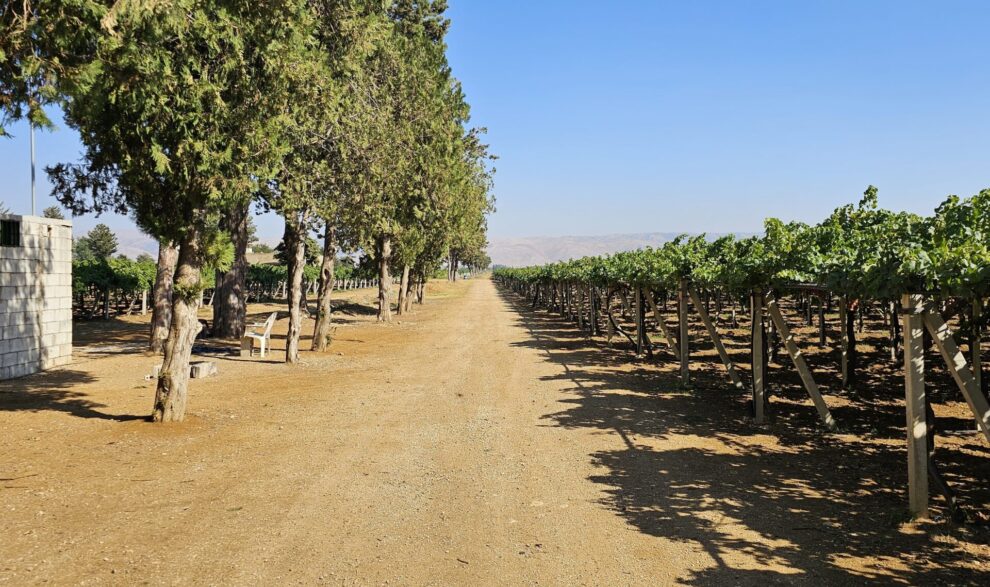Whereas Lebanese export grapes usually find their way to the Gulf States or Asia, Natagri’s Fadi Sarkis focuses steadfastly on Europe. “I often visit the trade shows in Berlin and Madrid to get better acquainted with European market requirements. My company is one of the few in Lebanon exporting grapes to that commercially exciting destination,” Fadi begins proudly.
But, the grower and exporter’s ambition is even further-reaching, not in distance – more distant markets are not yet in his plans – but in the role of a frontrunner that he wants to assume. “I want to get other growers on board, so, together, we can put Lebanon on the map in Europe as the ideal grape partner. Our strengths are clear: exceptional quality and a unique marketing window from October to December.”

Fadi Sarkis has planted a lot of Crimson seedless for the European market
First stop: The Netherlands
Fadi founded the cultivation and export company Natagri in 2015, with a treasure trove of know-how regarding European preferences regarding varieties, consumer experience, packaging, MRLs, and all sorts of specifications. “I invested heavily in meeting all those requirements, paying special attention to cultivation management. That is and always will be the foundation. It cost me time, effort, and still a fair amount of money because you can’t get the needed inputs in Lebanon. But the European market is more than worth it. It’s reasonably close, large, well-structured, ethical, and has an interesting demand in the last three months of the year,” he says.

Grapes packed in 500 gram punnets
In 2017, Fadi sent his first shipment of grapes to the Netherlands. Since then, he has added the United Kingdom, and, via the Netherlands, Poland, Denmark, and Norway. “Most exports go through the port of Rotterdam. That’s the most economically profitable way. It’s twice as fast – nine days, six on the boat, and three on the road – via the port of Koper in Slovenia, but that’s more of an emergency solution for extra orders and such. Those exporting to Kenya from Lebanon can reckon on 30 days, and to Singapore and Malaysia, also two common destinations, on 20 days without transshipment. We prefer Europe.”
Strength in numbers
Fadi understands other growers and exporters choosing to export mostly to the Gulf States and, to a lesser extent, Asia. After the closure of the Saudi Arabian market, they can smoothly sell their free varieties there, albeit mostly not directly, but on a commission basis. Even so, he is trying, as a ‘service center,’ to bind other growers to him. They can be stronger together in the lucrative European market.

Unlimited possibilities for expanding grape cultivation in the Bekaa Valley
“In Lebanon, there’s no culture of association via cooperatives. I suspect there’s too little mutual trust. That’s exactly what I’m creating, though privately. I want to group the cultivation units to enjoy scale economies operationally and on the supply and demand side. On the demand side through purchasing inputs, on the operational side with centralized crop management, quality assurance, packaging, transportation, and administration, and finally on the supply side with a joint marketing and sales department,” Fadi explains.
Crimson
According to him, Lebanese growers produce around 130,000 tons of grapes annually, of which 20,000 to 30,000 tons are exported. Local consumption is high, but hardly any varieties carry royalties due to limited government support in that area. “That’s one of our biggest problems. I’m betting on Crimson, a free variety that does well in the European market, especially toward the end of the year, our peak period. It’s not the easiest variety to grow, and it only reaches an average yield of 30 tons/ha, but, income-wise, it never disappoints.”

Modern packing station
And that, of course, has much to do with the fruit’s quality. “In comparison with neighbouring countries’ Crimson grapes, Lebanese ones have the advantage of adjoining crispness to rich taste. The dry cool weather we have the privilege to have throughout the fall, especially in the Bekaa area, with night temperatures of 10-12°C and 30-35° during the day, makes its cultivation and harvest less risky. The grapes can ripen more calmly, and crop management is less complex. There’s a good reason why, 3,000 years ago, the Phoenicians were already expert grape growers,” says Sarkis.
Of course there are serious regional competitors in this area, such as Egypt, Turkey and Iran, but Lebanon’s historic experience and technology advancement in grape growing makes this small country count on the international export balance of the region, according to Fadi. “In stone fruit they’re formidable opponents. And in wheat and potatoes. There, Syria controls the market and sets the price. They have far more land available, and their costs, including labor, are lower. But in grapes, we are proud to say, we can set the bar quite high.”

Investments in horticulture sorely needed
Given the product’s quality, sales are no issue. The challenges, Fadi says, lie at the supply chain’s start: investment to raise the fragmented Lebanese horticultural sector to a higher level is sorely lacking. Money is needed for farm implementation and expansion, crop and variety selection, cultivation techniques, postharvest, and certifications. “We can’t rely on government support even to promote the product abroad. And, until recently, local private investors were far more interested in other economic sectors, such as tourism. That’s somewhat understandable since, in our sector, it takes seven to eight years to see your money flow back,” he explains.” Not everyone wants to wait that long. But in the case of modern grape growing, the profitability after that is very high, with an average of 30-60% and peaks of 100% in good years.”
According to Fadi, that interest has been rising for the past five years. Still, many Lebanese investors are unfamiliar with the sector and, thus, make incorrect strategic decisions. “It seems the best way is to start initiatives yourself and then enter into specialized international partnerships. That’s what I do. With the right plan, you can definitely attract investment. You just have to know which crop and variety you want to grow. You need a certain volume, your organization and cultivation management must be on point, and you must have a market in mind. And don’t forget the necessary certifications, like GlobalGAP, GRASP, Smeta, and BRC. Once you’ve done your homework, you’re in a strong position to seek partners. Lebanon, after all, has boundless potential,” he concludes.
In that sense, Fadi is obviously delighted with the USAID projects – which encourage growers and investors to modernize cultivation – and the CBI’s help in opening up marketing opportunities. That includes exhibiting at important trade fairs, such as in Madrid in early October, where Natagri will be present at the Lebanon pavilion (Hall 1, stand 1C10).
For more information:
Fadi Sarkis (CEO)
Natagri
2 Park Avenue
Beirut Central District (Libanon)
Mob: +961 3 495 346
Tel: +961 8 542 332
fadi.sarkis@natagri.co
Source : Fresh Plaza
















